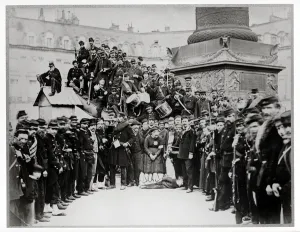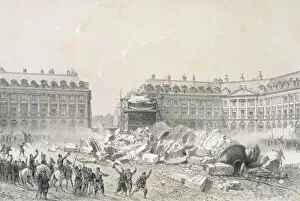Political Symbol Collection
"Political Symbol: The Controversial Fall of the Vendome Column in Paris" In the tumultuous era of 1871
All Professionally Made to Order for Quick Shipping
"Political Symbol: The Controversial Fall of the Vendome Column in Paris" In the tumultuous era of 1871, a powerful political symbol emerged from the heart of Paris - the iconic Vendome Column. This towering monument stood tall in Place Vendome, representing Napoleon Bonaparte's military triumphs and imperial reign. However, it soon became a focal point for dissent and rebellion during one of France's most turbulent periods. On that fateful day in March 1871, tensions reached their boiling point as demonstrators flooded the streets surrounding Rue de la Paix. Chaos ensued as authorities attempted to disperse the crowd, resulting in an engraving capturing this historic moment by Burn Smeeton. The image immortalizes the intense clash between protesters and law enforcement at one of Paris' most renowned landmarks. Preparations for destroying the Napoleon Column were underway shortly after, depicted vividly in an illustration from Cassell. As revolutionary fervor gripped Paris during the Commune uprising, radicals sought to erase symbols associated with monarchy and imperialism. The column's impending destruction became a potent statement against oppressive regimes. April 1871 witnessed another depiction of this monumental event through an engraving captured by an unknown artist. It portrays the dramatic fall of the Vendome Column itself – a symbolic act that sent shockwaves throughout France and beyond. This black-and-white photograph stands as a testament to both defiance and upheaval during these transformative times. The significance of this political symbol continued to resonate on May 29th when Federes gathered before its ruins amidst vibrant watercolors on paper created by anonymous artists. These images capture not only their presence but also serve as a reminder that even amid chaos; people found solace in unity against perceived oppression. Another striking visual representation emerges through yet another artwork depicting "The Fall of Vendome Column During Commune. " This lithograph showcases how this once-mighty structure lay shattered on Parisian streets, leaving behind a void that demanded attention and reflection.









